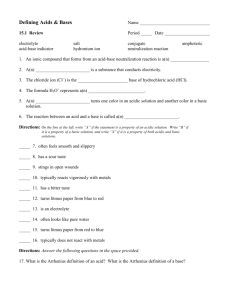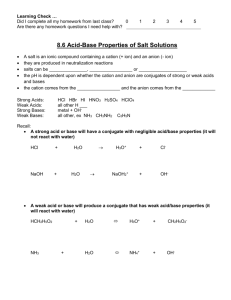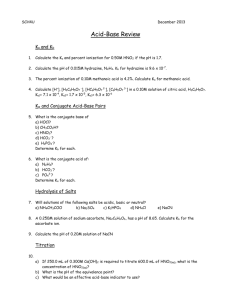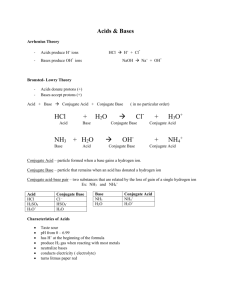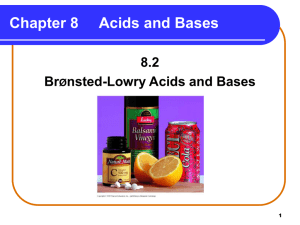Conjugate Acid-Base Pairs
advertisement
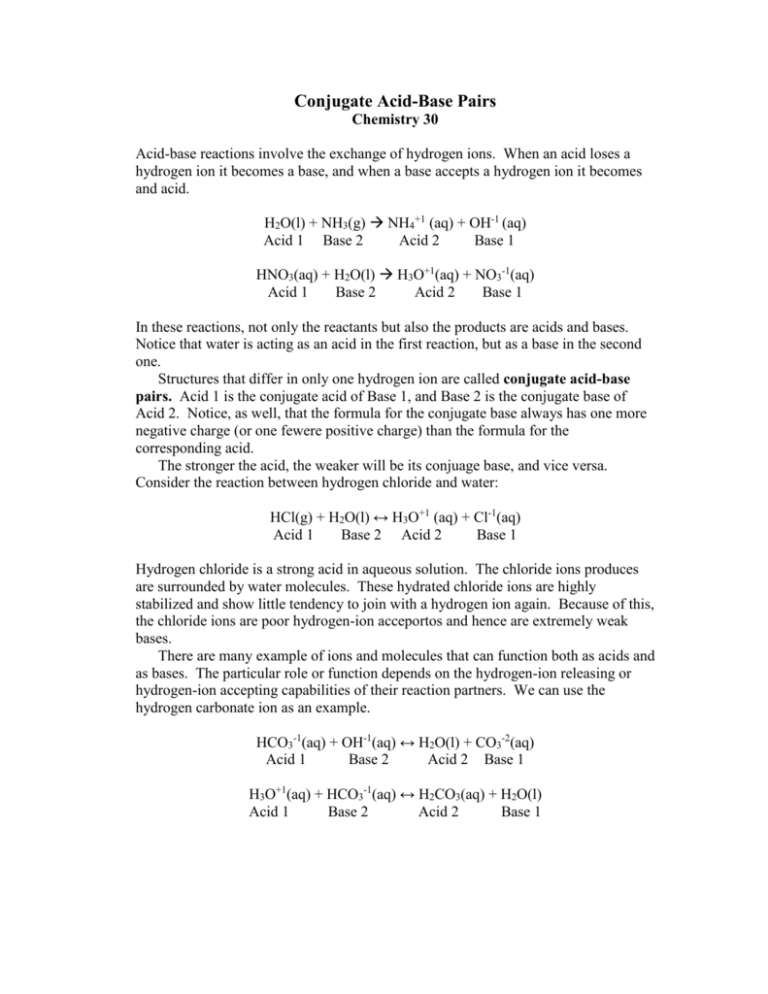
Conjugate Acid-Base Pairs Chemistry 30 Acid-base reactions involve the exchange of hydrogen ions. When an acid loses a hydrogen ion it becomes a base, and when a base accepts a hydrogen ion it becomes and acid. H2O(l) + NH3(g) NH4+1 (aq) + OH-1 (aq) Acid 1 Base 2 Acid 2 Base 1 HNO3(aq) + H2O(l) H3O+1(aq) + NO3-1(aq) Acid 1 Base 2 Acid 2 Base 1 In these reactions, not only the reactants but also the products are acids and bases. Notice that water is acting as an acid in the first reaction, but as a base in the second one. Structures that differ in only one hydrogen ion are called conjugate acid-base pairs. Acid 1 is the conjugate acid of Base 1, and Base 2 is the conjugate base of Acid 2. Notice, as well, that the formula for the conjugate base always has one more negative charge (or one fewere positive charge) than the formula for the corresponding acid. The stronger the acid, the weaker will be its conjuage base, and vice versa. Consider the reaction between hydrogen chloride and water: HCl(g) + H2O(l) ↔ H3O+1 (aq) + Cl-1(aq) Acid 1 Base 2 Acid 2 Base 1 Hydrogen chloride is a strong acid in aqueous solution. The chloride ions produces are surrounded by water molecules. These hydrated chloride ions are highly stabilized and show little tendency to join with a hydrogen ion again. Because of this, the chloride ions are poor hydrogen-ion acceportos and hence are extremely weak bases. There are many example of ions and molecules that can function both as acids and as bases. The particular role or function depends on the hydrogen-ion releasing or hydrogen-ion accepting capabilities of their reaction partners. We can use the hydrogen carbonate ion as an example. HCO3-1(aq) + OH-1(aq) ↔ H2O(l) + CO3-2(aq) Acid 1 Base 2 Acid 2 Base 1 H3O+1(aq) + HCO3-1(aq) ↔ H2CO3(aq) + H2O(l) Acid 1 Base 2 Acid 2 Base 1 Questions: 1. What is the conjugate base for each of the following acids? a. NH3 b. H3O+1 c. HSO3-1 d. NH4+1 e. H2PO4-1 2. What is the conjugate acid for each of the following bases? a. PO4-3 b. NH3 c. N HCO3-1 d. CH3OH 3. Complete the following acid-base reactions, assuming that only one hydrogen ion is exchanged. Identify the conjugate acid-base pairs by writing them below the equations a. H3PO4(aq) + NH3(aq) b. CO3-2 (aq) + H2SO4(aq) 4. Which of the following do not represent a conjugate acid-base pair: a. SO3-2 and SO2 b. CO3 -2 and CO c. H3O+ and H2 d. NH4+ and NH3 5. For each of the following reactions identify, where possible, the acid-base conjugate pairs: a. CH3CO2–1(aq) + H20(l) ↔ CH3CO2H(aq) + OH-1(aq) b. HClO(aq) +CH3NH2(aq) ↔ CH3NH3+1 (aq) + ClO-1(aq) c. NaH(s) + H2O(l) ↔ NaOH(aq) + H2(g) d. ClCH2CO2H(aq) + H2O(l) ↔ ClCH2CO2-1(aq) + H3O+1(aq) 6. List the conjugate acids for the following Bronsted bases a. OH – b. CO3 2c. NO3 – d. HCO3 – e. CN – 7. List the conjugate bases for the following Bronsted acids a. H2SO4 b. HPO4 2c. HCO3 – d. H3O + e. H2PO48. Which of the substances listed above could be amphoteric?



